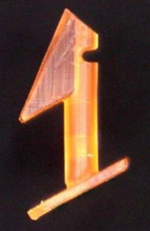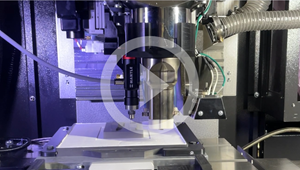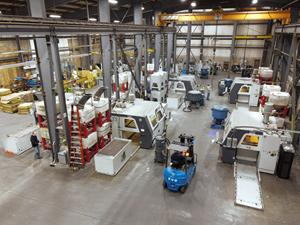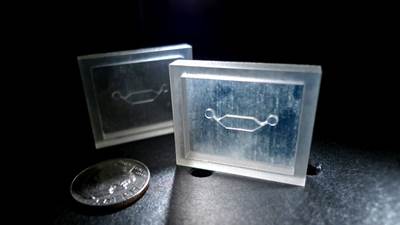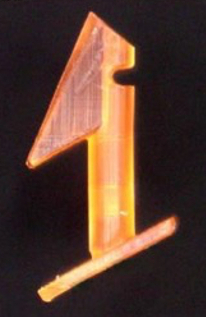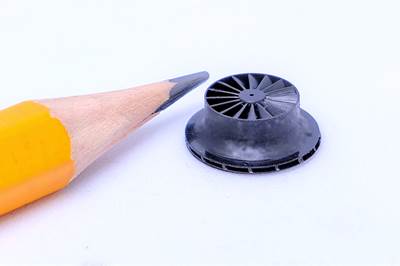To watch the process is almost like witnessing something magical, and in fact the footage looks more like it belongs in a nature documentary than something that was filmed inside a 3D printer. A tree-like structure rises into the frame, each transparent limb stretching out from those that came before in an elegant dance. In a matter of seconds, a network of tiny branches is complete, 3D printed entirely from ice.
This ice 3D printing process is the result of research currently underway at Carnegie Mellon University. Professors Burak Ozdoganlar and Philip LeDuc, along with PhD student Akash Garg, have been exploring a method for recreating vasculature — the blood vessels running through our organs, skin and other tissues — for biomedical applications including artificial organs and tissues.
“Vascularization has been a key issue in tissue scaffolds,” Ozdoganlar says. “You can create cell clusters in a lab that are quite large, but if they are not vascularized, then those cells in a short period of time end up dying because they don’t get nutrients and dispose of materials. That has been the Holy Grail — being able to create three-dimensional vasculature similar to what we see in the human body.”
Part of the problem is just how tiny these blood vessels are, on the order of tens of microns. But that’s part of the opportunity here as well — mastering the ability to print small enough to mimic blood vessels has other potential applications for microscale manufacturing.
3D Printed Ice as a Sacrificial Pattern
With this ice 3D printing method, researchers are not building the vessels or desired objects directly. Instead, the ice is sacrificial tooling: printed, coated in another material, and removed to leave behind a smooth-walled, finely detailed mold. The ice serves as a pattern that is strong and rigid enough to hold its shape for molding, yet simple to remove from its cavity.
Previous work that looked at printing wax templates for vasculature failed because the wax could not hold its shape adequately in three dimensions, and removing it risked introducing byproducts or deforming the geometry. It was Garg who suggested 3D printing instead with water. The team leveraged an existing droplet deposition device, converting it into an ice 3D printer with the integration of a build plate kept extremely cold (-35°C to be precise). The build plate is the only mechanism for motion as well as for freezing — as water droplets are deposited to its surface or on top of existing ice structures, they freeze rapidly in place, holding their shape and allowing for impressive geometric features such as overhangs as close to horizontal as 80 degrees.
Once complete, ice “patterns” in the shape of the desired internal passageways can be transferred — still on their frigid build plate — to the vat of collagen, resin or other material that requires these internal structures. This material is cured, and the ice can then be melted or sublimated away.
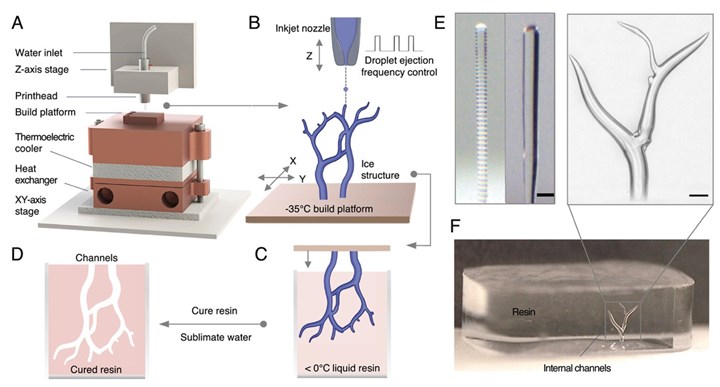
Ice 3D printing is possible with a custom 3D printing platform (A) that uses an inkjet nozzle to eject water droplets onto a cold build platform (B). Completed ice prints can be submerged into a second material such as liquid resin (C), which is then cured so that the water can be sublimated out to produce the final form (D, F). Frequency of the deposition makes various geometries possible (E). Image Credit: https://doi.org/10.1002/advs.202201566
Sublimation — moving straight from the solid to the gas state of a material — is often the ideal, Ozdoganlar says. Although water is one of the most biocompatible materials in the world (and therefore avoids the contamination issues posed by wax), melting it into water before removal could damage the delicate structures or leave liquid trapped inside. The best and most reliable way to remove it is to convert it into water vapor that can exit the structure, leaving no trace behind.
Freeform Freezing
Aside from temperature, 3D printing with ice also requires more precise control over motion and deposition. Typical G code doesn’t work for ice printing because of the water droplets’ behavior; each new droplet forms a water pool (akin to the meltpool seen in other processes) before it freezes that gets progressively larger the farther away the droplet is deposited from the build plate. Printing straight up without changing any parameters eventually results in an inverted cone shape, rather than a straight column. To compensate for this, researchers had to develop their own control software to modify the frequency of the water droplets as the build progresses; the farther from the build platform, the lower the frequency must be to allow time for each droplet to freeze.

The geometry of the ice structures is controlled by both the size of the droplet (nozzle diameter) and the frequency. Smaller droplets freeze more quickly and greater frequency creates smoother forms. Photo Credit: Supporting Information from https://doi.org/10.1002/advs.202201566
But the rapid freezing of the water droplets also opens this platform up for greater geometric freedom. Rather than printing structures by depositing them one layer at a time, the ice printer allows for printing one feature at a time, in a continuous manner along the axis or curve of the structure. Transitions from droplet to droplet can be very smooth, with no layer lines or other artifacts of the process.
“This is true freeform printing,” DeLuc says. “We just grow the ice structures in the directions that we want to grow them.”
“Being able to control the droplet frequency and the motion simultaneously enables us to create the structures without any support material,” Ozdoganlar says. “We can literally grow the tree trunk and the branches, rather than going layer by layer.”
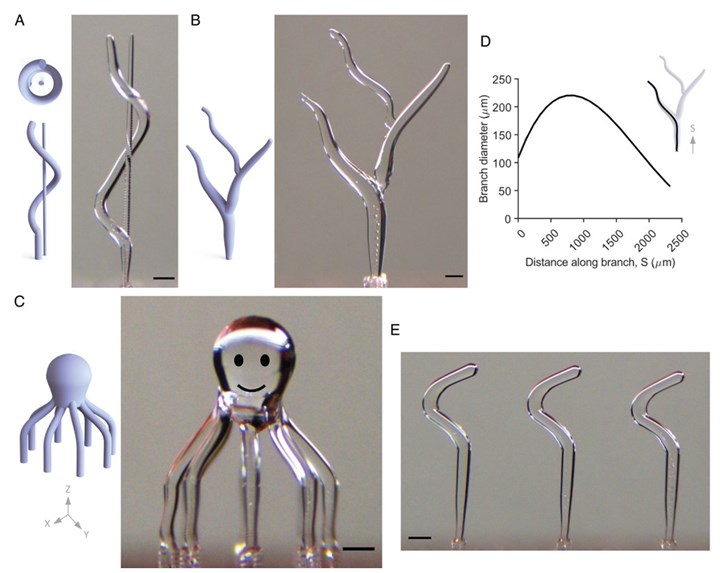
More examples of what is possible with the ice 3D printing process: A helicoil coil geometry with independent center pillar (A); the branched tree structure pictured at the top of this article (B); an octopus geometry with eight 90-micron-diameter tentacles (C; face features added using image processing); and a zigzag geometry (E). Photo Credit: https://doi.org/10.1002/advs.202201566
The Future for Ice 3D Printing
The team has been able to print microscale features down to 20 microns with the existing equipment, and is working on upgrades to the printer that will allow for finer details, larger builds and even fully horizontal features. Artificial intelligence and machine learning could be applied to make the process self-correcting in the future.
(Just one possible use for machine learning in additive manufacturing; another also from Carnegie Mellon.)
As to where ice 3D printing could go next, Ozdoganlar and LeDuc have a lot in process and understandably decline to give too much away. While the work so far has been focused on biomedical applications, the two see plenty of other uses in microfluidics, soft robotics and even art.
Related Content
3D Printing Molds With Metal Paste: The Mantle Process Explained (Video)
Metal paste is the starting point for a process using 3D printing, CNC shaping and sintering to deliver precise H13 or P20 steel tooling for plastics injection molding. Peter Zelinski talks through the steps of the process in this video filmed with Mantle equipment.
Read More3D Printed End of Arm Tooling Aids Automation
Frustrations with traditional end of arm tooling led Richard Savage to start 3D printing custom versions for injection molding applications, eventually founding a company to fill this niche.
Read MoreLooking to Secure the Supply Chain for Castings? Don't Overlook 3D Printed Sand Cores and Molds
Concerns about casting lead times and costs have many OEMs looking to 3D print parts directly in metal. But don’t overlook the advantages of 3D printed sand cores and molds applied for conventional metal casting, says Humtown leader.
Read MoreCopper, New Metal Printing Processes, Upgrades Based on Software and More from Formnext 2023: AM Radio #46
Formnext 2023 showed that additive manufacturing may be maturing, but it is certainly not stagnant. In this episode, we dive into observations around technology enhancements, new processes and materials, robots, sustainability and more trends from the show.
Read MoreRead Next
Where 3D Printing Makes Sense for Micro Medical Devices
A contract manufacturer uses stereolithography to produce high-quality medical devices on a micro-scale for prototyping and end use.
Read MoreCan Microscale 3D Printing Reduce Surgeries for Glaucoma Sufferers?
Boston Micro Fabrication (BMF) is exploring this promise. Eye stents are made of metal today. Fine-detail additive manufacturing can enable polymer instead, improving patient experience.
Read MoreMicro 3D Printer Complements Micro Moldmaking Capabilities
For micro mold provider Accumold, the Nano Dimension 3D printer provides a way to produce micro-scale prototypes and rapid tooling.
Read More

.jpg;width=70;height=70;mode=crop)

